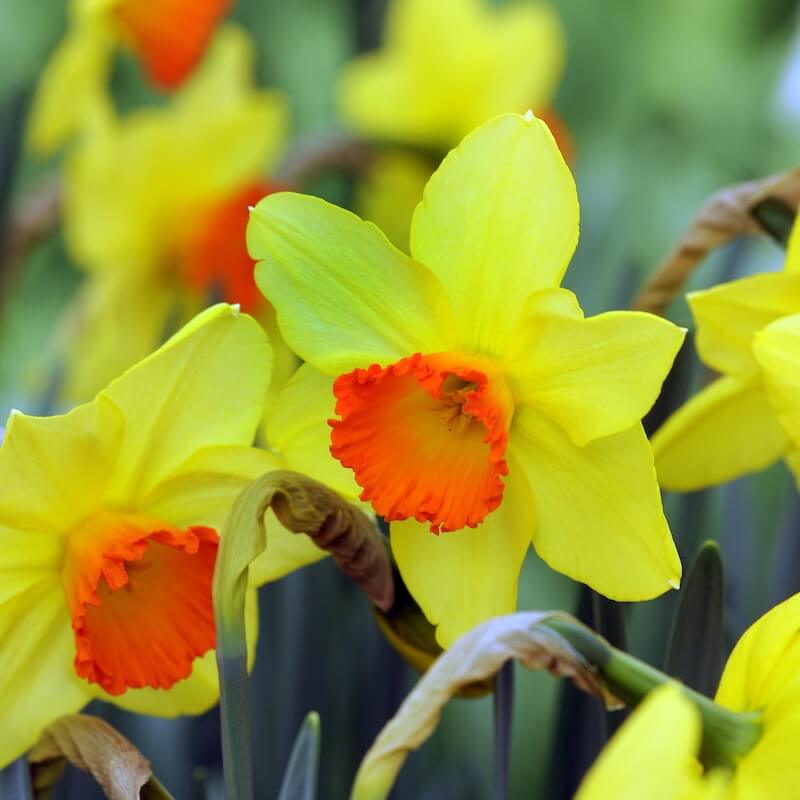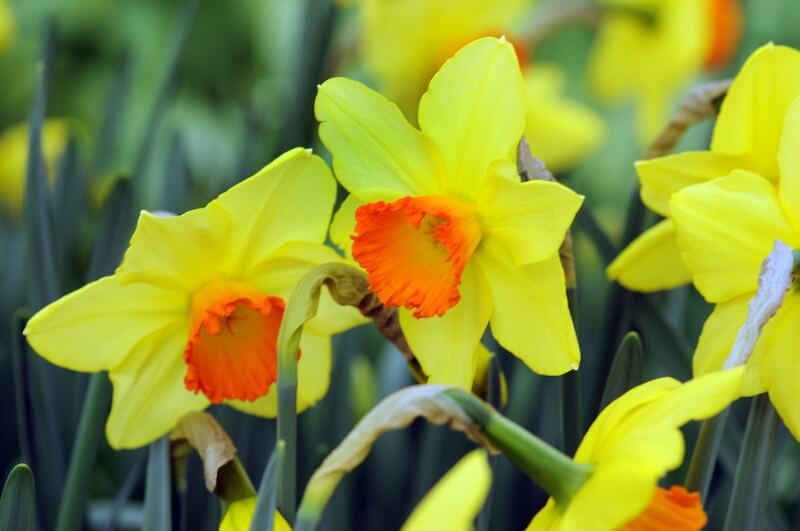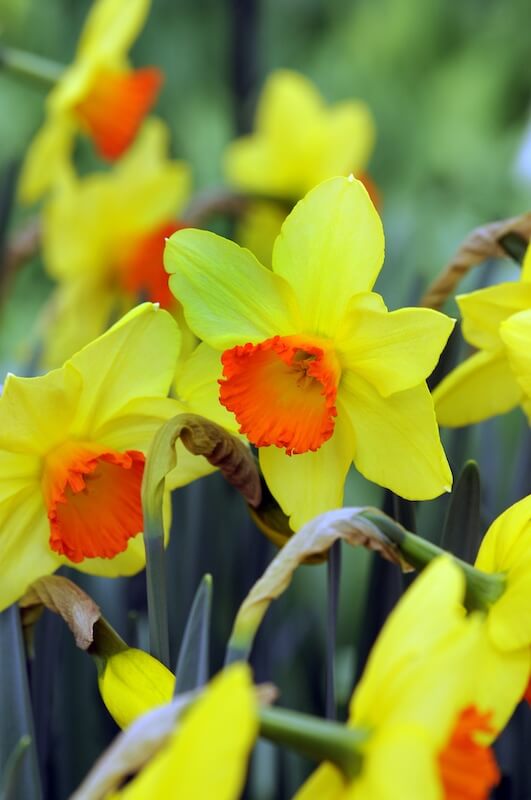
Position
- Full sun to light shade; flowering is richest in a sunny spot
- Sheltered from strong, drying winds
- Equally effective naturalised in grass, gravel beds, borders or large containers
Hardiness
- Tolerates winter lows down to around –20 °C (–4 °F)
- A light autumn mulch over the bulb bed helps establish plants in very exposed sites
Soil
- Fertile, well-drained soils such as loam or sandy loam
- Benefits from soil improvement at planting with garden compost or well-rotted manure
- Avoid heavy, waterlogged clay, which can cause bulb rot
- Adaptable to acid, neutral or alkaline conditions
- Performs best where organic matter helps retain moisture without waterlogging
- Grab a soil test kit and ensure the perfect conditions for growth
Height
- Clumps mature to produce stems about 30–35 cm (12–14 in) tall each spring
Seasons of Interest
Additional Notes
- Plant bulbs in autumn, 10–12 cm deep and 8–10 cm apart, in drifts or clusters for best impact
- Leave foliage until it is entirely yellow before cutting back to allow the bulbs to replenish their energy
- Divide and replant congested clumps every 3–4 years once leaves have died down
- Dead-head spent blooms to maintain a neat display and direct energy back into the bulbs
- Excellent for naturalising under deciduous trees—lift and replace turf after flowering to avoid damage
- Suitable for pot culture in deep containers with free-draining compost; move to a frost-free spot in winter
- All parts are mildly toxic; handle bulbs with gloves and keep away from pets and children
Narcissus Red Devon - Reliable Large Cupped Blooms for Spring Colour
The Red Devon daffodil, also known as Narcissus Red Devon, is one of the most cheerful flowers you can grow in spring. With its bright yellow petals and striking orange cup, this large-cupped daffodil is a showstopper in any garden. Planting these daffodil bulbs ensures a colourful, uplifting display year after year. Whether you grow them in borders, pots, or as cut flowers, Red Devon daffodils bring joy to every gardener.
What makes Narcissus Red Devon so special?
Narcissus Red Devon is admired for its large flowers and bold contrast of yellow petals with a vibrant orange cup. The perianth segments form a wide backdrop for the central cup, creating a dramatic display. Each flower can reach up to 11cm across on strong, upright stems, making it one of the finest large-cupped daffodils.
The RHS has recognised this variety for its outstanding qualities. Gardeners love it for its cheerful colour and reliable performance. It’s a perennial that will naturalise easily when planted in the right spot, rewarding you with blooms year after year.
The Red Devon daffodil is also versatile. It works equally well in a border, a container, or as part of a spring garden mix. Its stout stems and large flowers make it an excellent choice for cutting, allowing you to enjoy them indoors as well.
When is the best time for planting Red Devon daffodil bulbs?
Autumn is the perfect season for planting daffodil bulbs. The cool temperatures allow the bulbs to establish roots before winter sets in. Aim to plant bulbs from September through November, before the soil becomes too cold or waterlogged.
Plant bulbs 10–15cm deep in well-drained soil. Place them with the pointed tip facing upwards and cover firmly. If you’re planting several, space them 8–10cm apart for a bold display in spring. Always wear gloves when handling flower bulbs, as they can irritate the skin.
Moist soil helps bulbs establish, but it should never be waterlogged. If your garden tends to hold water, consider raised beds or pots with free-draining compost. A mulch layer helps retain moisture and protects bulbs through winter.

How should you prepare the soil for daffodil bulbs?
Red Devon daffodil bulbs thrive in well-drained soil enriched with organic matter. Digging in compost or well-rotted manure improves structure and fertility. This ensures bulbs receive the nutrients they need for strong roots and large flowers.
The soil should be moist but not soggy during growth. Poor drainage can lead to rotting. If you have heavy clay, mix in grit or sand to improve drainage. For sandy soils, adding compost helps retain enough water for the bulbs.
Position bulbs in full sun or light shade. Full sun encourages the best bloom, while light shade works in warmer gardens. In either case, ensure bulbs receive several hours of light each day.
What is the ideal planting depth for large cupped daffodils?
Large cupped daffodil bulbs, such as Narcissus Red Devon, should be planted at a depth of 10–15cm. This depth allows the bulb to anchor securely and produce upright stems. Plant bulbs too shallow and they may topple, too deep and they may struggle to bloom.
When planting in pots, select a container that is deep enough to accommodate the bulbs comfortably. Ensure there are drainage holes, as bulbs dislike sitting in wet compost. Place a layer of grit at the base for added drainage.
Spacing is equally important. Leave 8–10cm between bulbs to give each one room to develop—plant bulbs in groups for a stronger spring display, rather than scattering them singly.
Why is Narcissus Red Devon perfect for the spring garden?
Daffodil Red Devon is one of the most reliable spring bloomers. Its bright yellow petals and bold orange cup bring cheerful colour after the dull winter months. Few flowers announce spring as joyfully as this one.
In a spring garden, Red Devon blends beautifully with other bulbs such as tulips, crocuses, and hyacinths. Its large flowers make it a focal point in any planting scheme. Plant it near paths or entrances where its colour can be enjoyed up close.
This daffodil also offers value beyond the garden. As excellent cut flowers, they last well in vases, brightening your home. Their stout stems and large flowers enable them to stand upright without drooping.
Can you grow Red Devon daffodils in pots and containers?
Yes, these daffodils grow well in pots, making them ideal for smaller gardens, patios, or balconies—plant bulbs in a container at least 25cm deep. Use a free-draining compost mix with grit to prevent waterlogging.
Space bulbs closely in pots, but avoid overcrowding. Planting them in groups creates a more visually appealing display when they bloom. Place the containers in full sun or light shade, watering during dry spells in spring.
After flowering, allow foliage to die back naturally. You can either replant bulbs in the garden or keep them in the pot for the following year’s flowers. Adding fertiliser after blooming helps replenish the bulbs’ energy reserves.
How do you care for Red Devon daffodils after they bloom?
After blooming, deadhead the flowers to prevent the plant from diverting energy into seed production. Leave the foliage to die back naturally, as this feeds the bulb for the following year’s flowers. Never cut leaves too early, as this can weaken the bulb.
Fertiliser applied after flowering helps restore nutrients. Use a balanced feed to support root growth and bulb health. Keep soil moist during this period, but avoid overwatering.
Once foliage has died back, bulbs can be left in the soil to naturalise. In borders, they will return every spring, spreading over time. In pots, you can lift and store bulbs until the next planting season.
Where should you plant Red Devon daffodils in the garden?
Borders are a classic choice for Red Devon daffodils. Their large flowers stand tall on upright stems, creating a bold display at the front or middle of beds. Combine them with perennials that emerge later, so fading foliage is hidden as new growth appears.
They also work beautifully in naturalised drifts across lawns or under trees. Planting in clusters creates a meadow-like effect that returns each spring. Ensure the site has well-drained soil and receives enough light.
For a striking spring garden, mix Red Devon with other large cupped daffodils. The combination of shades and flower forms enhances the display, making it even more cheerful.
What makes Red Devon daffodils excellent cut flowers?
Red Devon daffodils are prized for their use as cut flowers. Their stout stems hold large blooms upright in vases, while their vibrant colour brightens any room. The orange cup contrasts beautifully with the yellow petals, creating a dramatic effect indoors.
When cutting, choose stems where the flower has just opened. Place immediately in clean water to extend their vase life. They last well compared to many spring blooms, making them excellent choices for cut flower arrangements.
Mix them with other seasonal flowers such as tulips or branches of blossom. Their cheerful presence makes any bouquet feel like a piece of spring brought indoors.
Do Red Devon daffodils return every year?
Yes, Red Devon is a reliable perennial that returns each spring. Once established, bulbs will flower year after year, often multiplying naturally. They will gradually form clumps, producing an even stronger display over time.
To encourage this, allow foliage to die back naturally and avoid cutting too early. A feed after flowering strengthens bulbs for the following season. With this care, you’ll enjoy narcissus Red Devon for many years.
Deer and rabbits usually leave daffodils alone, making them a low-maintenance choice. This resilience makes them ideal for gardeners who want cheerful, reliable spring flowers with little fuss.
From Darren’s Patch
There’s something about Narcissus Red Devon that captures the very essence of spring for me. Its bold yellow petals and rich orange cup always seem to lift the whole garden, even on grey days. I particularly admire how reliable these bulbs are – once planted, they consistently come back stronger each year with very little fuss. I like to group them in generous clusters in borders, where their bright faces greet me as I head into the garden. They’re also brilliant for cutting, adding a splash of cheer to the kitchen table.
![]()
Key Points to Remember
- Plant bulbs in autumn, 10–15cm deep, in well-drained soil
- Choose full sun or light shade for the best blooms
- Narcissus Red Devon features yellow petals with a bold orange cup
- Large flowers can reach 11cm across on upright stems
- Excellent cut flowers that last well in arrangements
- Allow foliage to die back naturally for the following year’s flowers
- Fertilise after bloom to replenish bulbs
- Naturalise in borders, lawns, or containers for a lasting spring display
- Deer-resistant and low maintenance
- Recognised by the RHS for outstanding garden performance
Narcissus Red Devon is a standout among large cupped daffodils, combining bold colour, reliability, and lasting spring charm. Whether planted in borders, naturalised in grass, or displayed in pots, its bright yellow petals and deep orange cup bring warmth and cheer to any garden. Easy to plant, simple to care for, and superb as a cut flower, this variety is a true spring classic. For gardeners seeking a dependable bulb with maximum impact, Narcissus Red Devon is an excellent choice. Plant it this autumn and look forward to a dazzling, uplifting display next spring.
Would you like to learn about other bulb varieties? Read about Narcissus Replete here.
For more information on Spring Flowering Bulbs for your garden, please click here.

Frequently Asked Questions
Q: What is Narcissus Red Devon?
A: Narcissus Red Devon is a classic large cupped daffodil admired for its bold colour and striking form. Each flower features bright yellow petals surrounding a deep orange centre, creating a cheerful display that brightens the spring garden. Known as a large-cupped daffodil, it produces large flowers up to 11cm across on stout, upright stems. Recognised by the RHS, this variety is both eye-catching and dependable, making it a favourite among gardeners who want strong, reliable daffodil bulbs that deliver a vibrant spring display year after year.
Q: When and how should I plant Red Devon daffodil bulbs?
A: For best results, plant bulbs of Narcissus Red Devon in autumn, ideally in September or October, when the soil is still warm. Plant the bulbs 10–15cm deep and twice their width apart in well-drained soil. A site in full sun or light shade is ideal for healthy growth and abundant blooms. Water lightly after planting to settle the soil and keep it moist through the autumn months. Planting in groups or drifts in borders, lawns, or naturalised areas ensures a bright and cheerful spring display.
Q: Can Red Devon daffodils be grown in pots or containers?
A: Yes, daffodil Red Devon thrives in pots and containers, making it suitable for smaller spaces or patios. When planting bulbs in a container, use a high-quality compost mixed with grit to ensure good drainage. Space the bulbs closely for a full, colourful display. Place the container in full sun or light shade, water when needed, and keep the compost moist but not soggy. Their strong, upright stems and large flowers make them excellent cut flowers too, providing vibrant colour both outdoors and indoors.
Q: How do I care for Narcissus Red Devon after flowering?
A: Once the cheerful blooms fade, deadhead the flowers to prevent seed production, but leave the foliage to die back naturally. The green leaves continue to feed the bulb, storing energy for the following year’s flowers. Avoid cutting the foliage too early, as this weakens the bulb. During dry spells, water lightly to keep the soil moist. A light feed can also support bulb strength. Over time, clumps may become crowded; lifting and dividing the bulbs every few years will maintain vigorous growth and ensure reliable spring displays.
Q: Where can I buy Narcissus Red Devon bulbs?
A: Gardeners can buy Narcissus Red Devon bulbs easily from local garden centres, nurseries, or trusted online suppliers. These large cupped daffodil bulbs are widely available in autumn, often sold in bulk for planting en masse or in smaller packs for pots and borders. Choosing quality bulbs from reputable suppliers ensures strong stems, large flowers, and lasting displays in your spring garden. Ordering early gives you the best selection, helping you secure healthy bulbs ready to plant for the following spring’s bloom.
